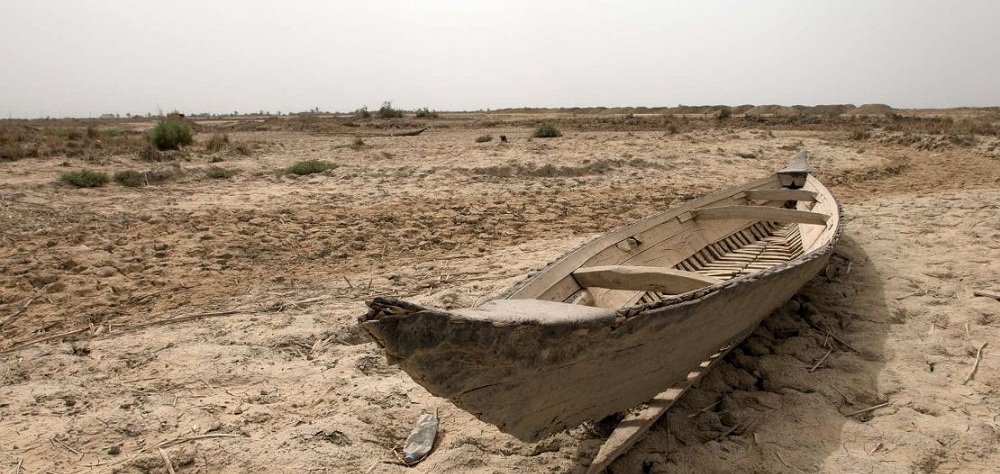Alwaght- These days, the draining of Sawa Lake in Al Muthanna province in southern Iraq has once again brought to spotlight the water crisis in this country. The increasing concern about the water crisis is coming while over the past weeks the dust storms across the country have been raising the Turkish dam construction projects as a crucial threat to the future of life in many regions of Iraq.
In addition, the uncoordinated decision of the Iraqi Kurdistan region to build three new dams and to sign an agreement to build four new dams with PowerChina company has further added to the concerns among Iraqi officials as well as residents of the southern and central regions.
Generally speaking, water is turning into a new challenge for Iraq, and possibly in addition to the southern provinces, larger parts of the country would be impacted by drought. Drought, sandstorms, and temperatures of more than 50 degrees have become increasingly common in Iraq. The ministry of water resources has also stressed that if no remedial measures are taken, the water share that Iraq receives from the Tigris and Euphrates rivers will go zero within the next 20 years.
Water levels down, Iraqi government discontented
Presently, the long droughts, human measures, and dam construction projects by Iraq's neighbors on Tigris and Euphrates rivers have been reasons for unprecedented water reserve decrease in the country. Recently, Aoun Diab, a senior adviser to the ministry of water resources, stressed that Iraq's water resources have shrunken by 50 percent since last year due to frequent droughts and low rainfall. From his viewpoint, the continuous drought in recent years, as well as the dam-building policies of the upstream countries, namely Turkey, Syria and Iran, are the main cause of a 50 percent decrease of the water level in this country. It is predicted that by 2035, Iraq will face a water deficit of more than 10 billion cubic meters.
Iraq, in fact, is one of the five most vulnerable countries in the world to climate change and desertification, despite its rich oil resources and the flow of the great rivers of Tigris and Euphrates. It has received very little rainfall in recent years, and its farmers are using very traditional irrigation methods, leading to waste of water. Many political and social observers warn of the consequences of the water crisis in this country. These warnings become even more alarming if we know that at the current rate, the country's population will increase to 51 million from the current 41 million in the next 10 years.
Water crisis's political and social repercussions
It is not just the environmental consequences that the water crisis can bring to Iraq. Water scarcity and drought can impact the social life of the Iraqis and even pave the way for popular protests in the southern and central provinces. Certainly, this is a predictable issue that in the future, the construction of dams on the Tigris and Euphrates will expose a large part of the population of the southern and central provinces to the threat of depopulation. Such a consequence is certainly an undeniable fact in the not-too-distant future and could become a major issue for Iraqi politics and governance.
Water crisis in the first place seems to be more of an environmental and non-political issue, but in the new era, environmental policy is one of the most political areas not only within borders of the countries but also in relations between neighbors. In relation to Iraq, the water crisis can be counted ultimately a political and important issue in the future equations of the country.
It should be taken into consideration that worsened water crisis can lead to depopulation of southern provinces. This would lead to a demographic change in the northern areas, an issue potentially intensifying the tensions between the central government and the Kurdish region in the north; because the Kurds seek to weaponize water crisis against Baghdad with the policy of building new dams in the northern regions, and also to protect themselves from the consequences of the drought in Iraq. This can ignite large-scale protests in various provinces and even civil war in Iraq.
Excessive Turkish dam construction and Baghdad discontent with Ankara water war
Definitely, the Turkish dam projects are the biggest factor to blame for deteriorating the Iraqi water crisis. About 80 percent of Tigris and Euphrates water originates from Turkey. During 2021, the two rivers' intake decreased by 50 percent. This decrease pace is expected to get faster. The Tigris River originates in the Toros Dağları mountains in Turkey, flows through Syria to southern Iraq, and reaches the Euphrates River in the Shatt al-Arab. It is 1850 kilometers long and has several tributaries, the most important of which are the Diyala River, the Upper Zab, and the Lower Zab.
In the 1950s, Turkey designed the plan of Ilisu Dam, a hydroelectric project that began construction in 2006 on the Tigris River near the village of Ilisu, along the border with Turkey's Mardin and Sirnak provinces and was finished and inaugurated in February 2018. In early June of the same year, the Turkish government began filling the dam's reservoir. Such Iraqi provinces as Mosul, Sulaymaniyah, Baghdad and Basra, are now affected by the filling process.
Like Tigris, Euphrates River has its origin in Turkey, passes Syria, and reaches Iraq. After entering Syrian town of Jarabulus in Aleppo outskirts, the river joins Raqqa and then Deir ez-Zor rivers, and continues to Bukamal town, where it enters Iraqi territory. It passes Babil, Karbala, Najaf, Al Diwaniyah, Al Muthana, and Dhi Qar to end in Mesopotamian Marshes in the south.
As part of Southeastern Anatolia Project, launched in the 1970s, Turkey built 5 huge dams on the Euphrates and 2 more are under construction. One is the huge Ataturk Dam that was completed in 1990 and can accommodate 48 billion cubic meters of water. Turkey continues to build dams on Tigris and Euphrates rivers, both life arteries to Syria and Iraq. These projects cut Iraq's water intake by 80 percent and Syria's by 40 percent.



























